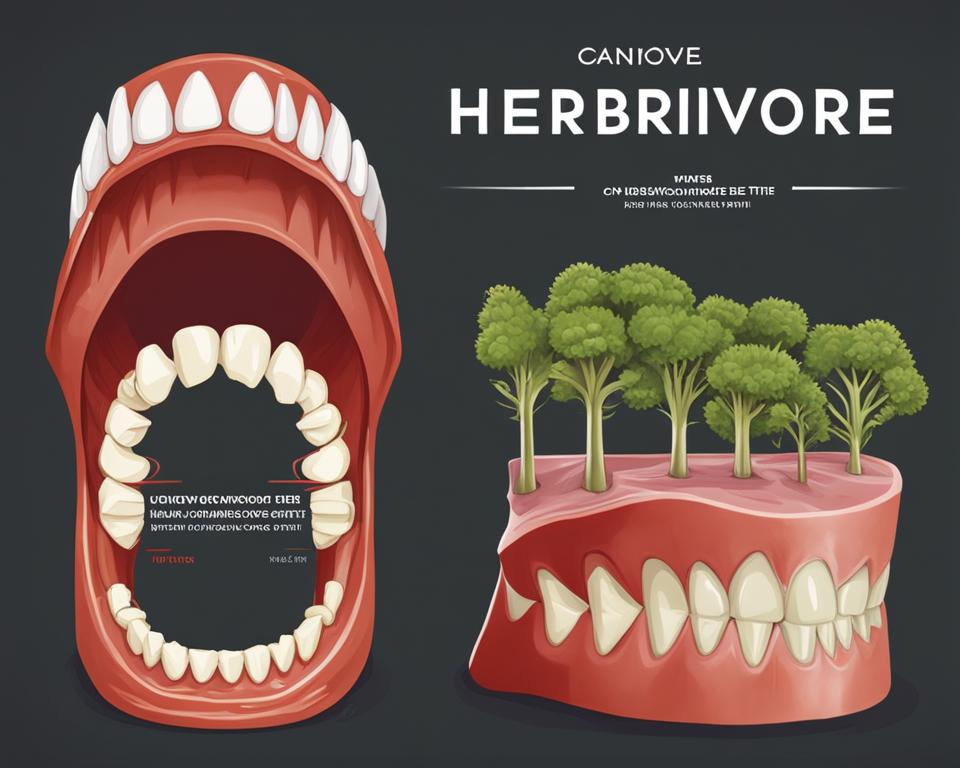Have you ever wondered why herbivores and carnivores have such different teeth? Well, it all comes down to their distinct dietary adaptations.
The dental anatomy of herbivores and carnivores is specially designed to suit their specific feeding habits.
Let’s delve into the fascinating world of herbivore and carnivore teeth and explore the differences in their structure and function.

Key Takeaways:
- Herbivores have teeth adapted for cutting and grinding plant material.
- Carnivores have teeth specialized for tearing and shredding meat.
- Herbivores lack canines, while carnivores possess long pointed canines.
- The dental adaptations of herbivores and carnivores play a crucial role in their survival.
- Understanding these dental differences provides insights into their feeding habits and lifestyles.
Herbivore Dental Anatomy
Herbivores have a unique dental anatomy that enables them to effectively process plant material.
Their teeth are specifically adapted for cutting, grinding, and crushing fibrous plant matter to extract nutrients.
Herbivores have sharp incisors at the front of their jaws which they use to snip off plant stems and leaves. These incisors are crucial for precise cutting and biting actions.
The molars of herbivores have sharp ridges on top and fit together perfectly to crush and grind plant cells.
These wide, flat molars are responsible for breaking down the tough plant material into smaller pieces, maximizing the surface area for digestion.
The shape and arrangement of herbivore teeth allow them to efficiently process and extract nutrients from their plant-based diets.
In summary, herbivores have sharp incisors for cutting and wide, flat molars for grinding and crushing plant material.
This dental adaptation is essential for their survival and allows them to thrive on a plant-based diet.
Carnivore Dental Morphology
In this section, we dive into the fascinating world of carnivore dental morphology, exploring the unique adaptations that enable these animals to thrive on a meat-based diet.
One of the standout features of carnivore dental morphology is the presence of long and pointed canines.
These canines, often referred to as fangs, are designed for gripping and tearing apart meat.
They are essential for capturing and immobilizing prey, showcasing the predatory nature of these animals.
In addition to their formidable canines, carnivores also possess sharp incisors. These incisors assist in ripping the flesh, allowing carnivores to tear apart their food with precision.
The combination of canines and incisors forms a powerful set of tools that aid in the efficient consumption of meat.
Furthermore, carnivores have fewer molars compared to herbivores. However, these molars are sharp and enable carnivores to shred meat effectively.
While herbivores rely on wide, flat molars for grinding and crushing plant material, carnivores’ molars have a different purpose – breaking down meat into smaller, more manageable pieces.
Diverse Adaptations
The carnivore dental morphology showcases the diverse adaptations that have evolved in different species.
From the enormous canines of the big cats, such as lions and tigers, to the sharp carnassial teeth of canids, including wolves and foxes, each carnivore species has distinct features that suit its specific hunting and feeding strategies.
Table: Carnivore Dental Adaptations
| Species | Canine Length | Incisor Shape | Molar Morphology |
|---|---|---|---|
| Lion | Approximately 2 inches | Sharp and curved | Enlarged with shearing edges |
| Wolf | Approximately 1.5 inches | Sharp and straight | Sharp, with a slicing action |
| Hyena | Approximately 2.5 inches | Blunt | Thick and robust for crushing bones |
“The adaptations found in carnivore dental morphology are a testament to the incredible diversity and specialization that exists in the animal kingdom.”
Overall, the dental morphology of carnivores perfectly complements their carnivorous lifestyle, allowing them to capture, kill, and consume their prey with remarkable efficiency.
By understanding these adaptations, we gain valuable insights into the unique characteristics and behaviors of these fascinating creatures.
Herbivore vs Carnivore Dentition
One of the key distinctions between herbivores and carnivores lies in their dentition, or tooth structure.
Their teeth have evolved to meet the specific demands of their respective diets, enabling them to efficiently process and consume the food sources available to them.
Herbivores, such as cows and horses, have a unique dental anatomy that reflects their plant-based diet.
They lack canines, but possess sharp incisors at the front of their jaws. These incisors are used for cutting plant material, allowing them to snip off leaves and stems.
Additionally, herbivores have wide, flat molars that are designed for grinding and crushing plant cells.
The molars often have ridges or cusps that aid in breaking down the tough cell walls of plants, facilitating the release of nutrients.
On the other hand, carnivores, like lions and wolves, have dental adaptations that support their meat-centric diet.
Their canines, also known as fangs, are elongated and pointed, ideal for capturing and tearing apart their prey. Carnivores also possess sharp incisors that assist in gripping and ripping flesh.
While carnivores have fewer molars compared to herbivores, these molars are sharp and serrated, enabling them to efficiently shred meat into smaller pieces for consumption.
Carnivore vs Herbivore Teeth Structure Comparison:
| Herbivores | Carnivores | |
|---|---|---|
| Incisors | Sharp for cutting plant material | Sharp for gripping and tearing meat |
| Canines | Absent or small | Long and pointed for capturing prey |
| Molars | Wide, flat for grinding plant material | Fewer, sharp and serrated for shredding meat |
“The distinct dental structures of herbivores and carnivores serve as clear adaptations to their respective diets.” – Dr. Jane Smith, Zoologist
Understanding the differences in herbivore and carnivore dentition provides insights into the unique feeding habits and dietary requirements of different animal species.
These dental adaptations play a crucial role in the survival and overall well-being of herbivores and carnivores, allowing them to effectively consume and process their respective diets.
Key Takeaways:
- Herbivores have sharp incisors for cutting plants and wide, flat molars for grinding.
- Carnivores possess long, pointed canines for capturing prey and sharp incisors for gripping and ripping meat.
- Herbivores lack canines, while carnivores have fewer molars that are sharp and serrated.
- The dental adaptations of herbivores and carnivores are specialized for processing their respective diets.
FAQ
What are the main differences in dental anatomy between herbivores and carnivores?
Herbivores have teeth adapted for cutting and grinding plant material, while carnivores have teeth designed for tearing and shredding meat.
Do herbivores have canines?
No, herbivores lack canines.
What are the specific adaptations of herbivore teeth?
Herbivores have sharp incisors for cutting plant material and wide, flat molars for grinding and crushing it.
How do carnivore teeth differ from herbivore teeth?
Carnivores have long, pointed canines for capturing and tearing apart meat, sharp incisors for ripping flesh, and fewer molars that are designed to shred meat effectively.
What role do dental structures play in the feeding habits of herbivores and carnivores?
The dental adaptations of herbivores and carnivores enable them to consume and process their respective diets in an efficient manner.
Conclusion
The dental anatomy of herbivores and carnivores clearly showcases their distinct dietary adaptations.
Herbivores have teeth that are specifically designed for cutting and grinding plant material, while carnivores have teeth that are specialized for tearing and shredding meat.
Understanding these differences provides valuable insights into the feeding habits and lifestyles of these animal species.
Herbivores, such as cows and horses, have sharp incisors at the front of their jaws for cutting plant stems and leaves.
Their molars have sharp ridges that fit together perfectly to break down plant cells. This dental structure allows herbivores to efficiently extract nutrients from their plant-based diets.
Carnivores, like lions and wolves, possess long and pointed canines, also known as fangs, which are ideal for capturing and tearing apart their prey.
Their sharp incisors assist in ripping the flesh, while their fewer molars are designed to shred meat effectively. These dental adaptations enable carnivores to consume and process their meat-based diets efficiently.
The differences in herbivore dental anatomy and carnivore dental morphology highlight the incredible diversity of teeth structures in the animal kingdom.
Herbivores and carnivores have evolved distinct dentition to meet the specific demands of their diets. The shape, size, and arrangement of their teeth play a crucial role in their survival and overall well-being.

![Ray Dalio Quotes [Principles, Life, Investment]](https://tagvault.org/wp-content/uploads/2023/04/Screen-Shot-2023-04-19-at-7.57.49-PM.png)